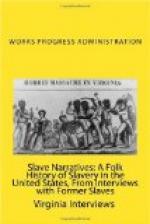“Yes ma’am, the Confederates used to come through lots. I remember how we used to go to the spring for water for ’em. Then we’d stand with the buckets on our heads while they drank—drank out of a big gourd. When the buckets was empty we’d go back to the spring for more water.
“Once the Yankees come by the place. It was at night. They went out to the quarters and they tried to get ’em to rise up. Told ’em to come on in the big house and take what they wanted. Told ’em to take anything they wanted to take, take Master’s silver spoons and Miss’ silk dress. ‘If they don’t like it, we’ll shoot their brains out,’ they said. Next morning they told Master. He got scared and moved. At that time we was living at Cloverport.
“It was near the end of the war and we was already free, only we didn’t know it. He moved on up to Stephensport. That’s on the Ohio too. He took me and a brother of mine and another black boy. While we was there I remember he took me to a circus. I remember how the lady—she was dressed in pink come walking down a wire—straight on down to the ground. She was carrying a long pole. I won’t never forget that.
“Not long afterwards I was married. We was all free then. My husband asked my master if he could marry me. He told him ’You’re a good man. You can come and live on my farm and work for me, but you can’t have Mattie.’ So we moved off to his Master’s farm.
“A little while after that his Master bought a big farm in Arkansas. He wanted to hire as many people as he could. So we went with him. He started out well, but the first summer he died. So everything had to be sold. A man what come down to bid on some of the farm tools and stock—come to the auction, he told us to come on up to Woodruff county and work for him. We was there 7 years and he worked the farm and I took care of myself and my babies. Then he went off and left me.
“I went in to Cotton Plant and started working there. Finally he wrote me and tried to get me to say we hadn’t never been married. Said he wanted to marry another woman. The white folks I worked for wouldn’t let me. I’d been married right and they wouldn’t let me disgrace myself by writing such a letter.
“Finally I came on to Hot Springs. For a while I cooked and washed. Then I started working for folks, regular. For 9 years, tho, I mostly washed and ironed.
“I came to Hot Springs on the 7th of February—I think it was 57 years ago. You remember Miss Maud—it was just before that big hail storm. You was here, don’t you remember—that hail storm that took all the windows out of all the houses, tore off roofs and swept dishes and table-cloths right off the tables. Can’t nobody forget that who’s seen it.
“Miss Mary, do you know Miss Julia Huggins? I worked for her a long time. Worked for her before she went away and after she came back. Between times I cooked for Mrs. Button (Burton—but called Button by everyone) Housley. When Miss Julia come back she marches right down to Mrs. Housley’s and tells me she wants me to work for her again. ’Can’t get her now,’ says Mrs. Housley, ‘Mattie’s done found out she’s black.’ But anyhow I went to see her, and I went back to work for her, pretty foxy Miss Julia was.




